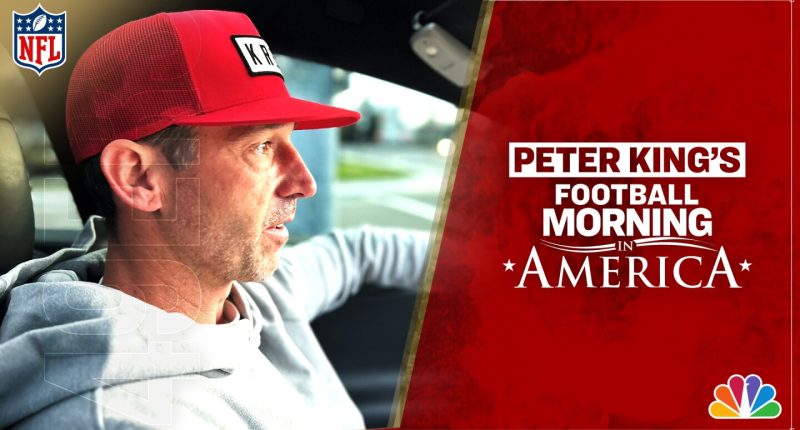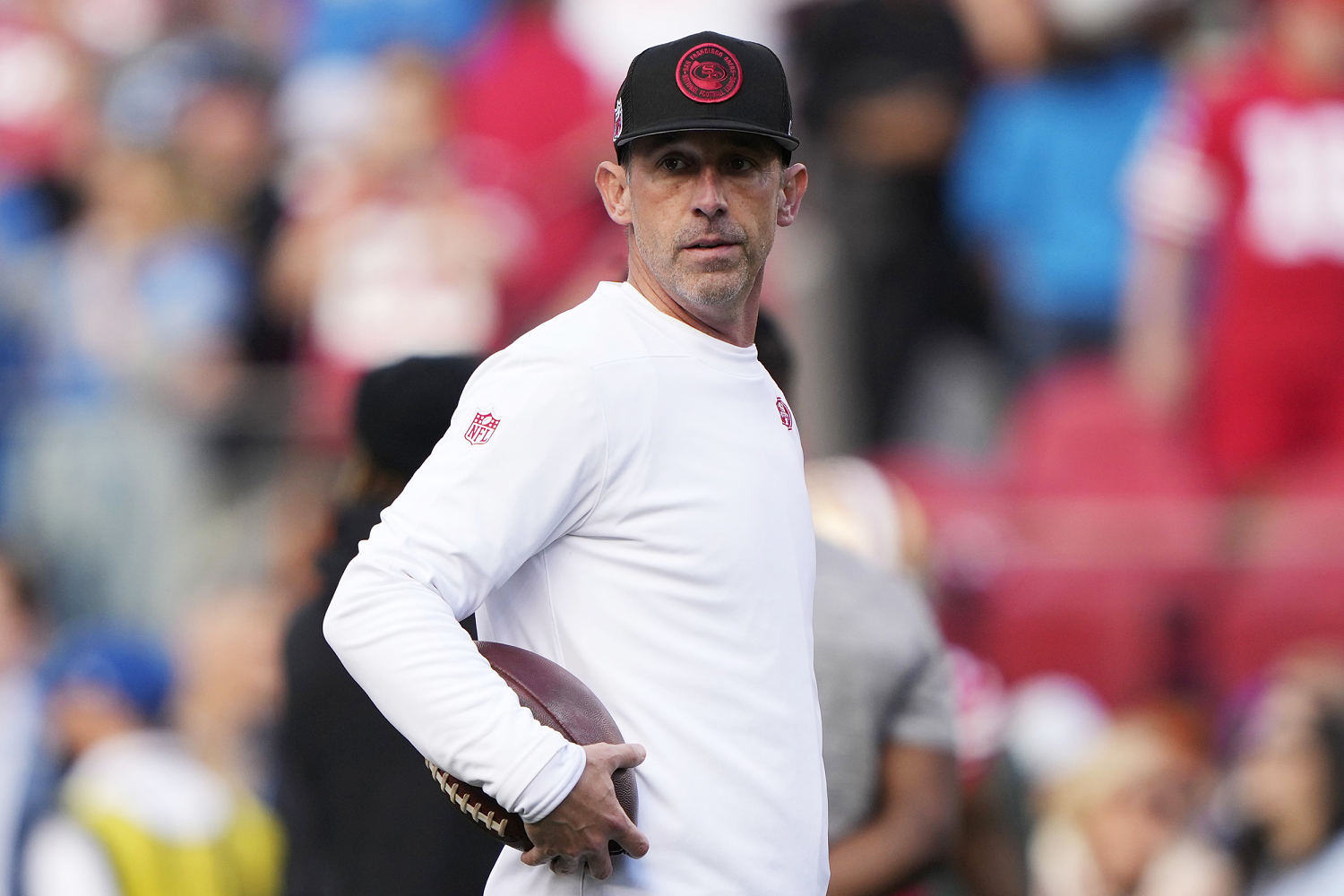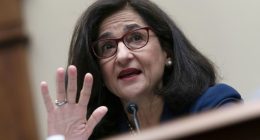
Early this season, a reader asked if I would name my all-time team, seeing as I was in my 40th season covering the NFL. No time like the off-week before the Super Bowl.
Instead of a first and second team, I’ll name a full team of 53 players. The last few will not be the best players, necessarily. But one of the things I’ve grown to like about the sport is how much of a team game it is. So on my team, I’m not going to have all the locks, all the obvious guys. One note to remember: I don’t include players (like Walter Payton) who I covered sparingly, but whose careers were at least half over by the time I started in the business in 1984.
It’s a fun exercise. I took two full days on it. When you see an odd pick here or wonder why Emmitt Smith and Drew Brees and Tony Gonzalez and Rod Woodson aren’t included, there’s no good reason, other than the players I picked are the ones I liked the most over the last four decades to impact games, to be winning players, to be the kind of players who don’t rest till they succeed.
Offense
Roster: 21.
Quarterback (4). Tom Brady, New England/Tampa Bay, 2000-’23; Joe Montana, San Francisco/Kansas City, 1979-‘94; Peyton Manning, Indianapolis/Denver, 1998-2015; Patrick Mahomes, Kansas City, 2017-present. Had to go chalk here. For those of you angry at those I left off—Brees, Favre, Rodgers, Elway—I understand. I guess I’d ask, Who’d you remove to put your guy on? I struggled to put four on the list, because no team has four QBs on a 53-man roster, but these are the four best I’ve ever seen. And putting Mahomes on after six starting seasons is easy. There are few quarterbacks, ever, except maybe Otto Graham, Brady and Montana, who’d be strong candidates for the Hall of Fame after their first six professional years starting.
Running back (3). Barry Sanders, Detroit, 1989-’98; LaDainian Tomlinson, San Diego/Jets, 2001-’11; Derrick Henry, Tennessee, 2016-present. Numbers four and five: Terrell Davis, Adrian Peterson. What’s there to say about the most beautiful runner in NFL history? Early in my SI days, he was the most genial and elusive interview subject; he never wanted to do them, but once cornered, Sanders was all class. And how did the man never suffer a major injury in 10 years making those cuts, playing 159 of 166 games? Tomlinson scored 33 touchdowns in one season, 2006. I covered him twice that year and wondered, Everyone knows he’s getting the ball near the goal line. Why can’t they stop him? Re: Henry: In my 40 seasons, I’ve never seen a back do what Henry did in 2019. Rushed for 211 yards in the final week of the season to clinch a playoff spot. Rushed for 182 yards in Foxboro to knock the Pats from the playoffs in Tom Brady’s last game there. Rushed for 195 yards to beat the top-seeded Ravens in Baltimore. The most physically dominating back in the game in the last half-century.
Fullback (1). Maurice Carthon, Giants/Indianapolis, 1985-’92. Came to the Giants the first year I covered them, 1985, from the USFL’s Trump-owned New Jersey Generals. What an amazing year. He started 19 games for the Generals, including a playoff game, then 18, including two playoff games, for the Giants, in a 10-month span. Three weeks off between seasons. A rock-solid blocker and totally unselfish, two crucial traits for a fullback.
Tackle (3). Anthony Munoz, Cincinnati, 1980-‘92; Jonathan Ogden, Baltimore, 1996-2007; Joe Thomas, Cleveland, 2007-’17. The year I covered Munoz, 1984, offensive line coach Jim McNally called me into his office one Monday afternoon and told me Munoz had played a perfect game the previous day. McNally had never graded a perfect game. Munoz married brute strength and technical perfection. Ogden, the first Ravens’ draft pick ever, was the first (and best) power forward playing tackle, 6-9 and athletic. You couldn’t get around him. Thomas went fishing instead of to Radio City on draft day, which portended his life in football. Just went to work every day for one of the worst teams in football and never complained, with that amazing streak of 10,363 straight plays. Imagine playing every snap for 10.5 years, in front of 20 different quarterbacks, for a team that lost all the time.
Guard (3). Russ Grimm, Washington, 1981-’91; Larry Allen, Dallas/San Francisco, 2004-’17; Jahri Evans, New Orleans/Green Bay, 2006-’17. I have these memories of the Gibbs-Parcells Era games in the NFC East, and I so admired the grit of that Washington team, personified by Grimm and that great line. Allen’s the strongest interior lineman I ever saw. Mr. Pancake. Re: Evans, I don’t think people understand his impact, and the fullness of his story. I thought he was the most important offensive teammate Drew Brees had, keeping Brees clean for a decade. Drafted out of tiny Division II Bloomsburg (Pa.), Evans won the starting right guard job 10 days into camp, started all 122 Saints games his first seven years and made four first-team all-pros. Crucial part of the best enduring offense of this century.
Center (1). Jason Kelce, Philadelphia, 2011-present. Apologies, Tom Nalen. Kelce was the most versatile center I’ve seen. He could mash and he could get out on the sweep and he could corkscrew the Tush Push. If there was an all-interview team for my 40 years, he’d make that too.
Tight end (2): Rob Gronkowski, New England/Tampa Bay, 2010-’21; Travis Kelce, Kansas City, 2013-present. Number three: Mark Bavaro. I went present-day over the Sharpe/Gonzalez crew, and ahead of Jason Witten. All worthy, but the post-season greatness swayed me. Gronk: four Super Bowls, five TDs. Kelce: In 21 playoff games, he averaged seven catches, 86 yards—when the D knows the ball’s coming to him early and often.
Wide receiver (4). Jerry Rice, San Francisco/Oakland/Seattle, 1985-2004; Randy Moss, Minnesota/Oakland/New England/Tennessee/San Francisco, 1998-2012; Hines Ward, Pittsburgh, 1998-2011; Tyreek Hill, Kansas City/Miami, 2016-present. Rice, Moss, no-brainers. Ward’s here because he’s the best blocking wide receiver I’ve seen, and he caught 1,000 passes. Loved his unselfishness. Teams with diva wide receivers who don’t block might have hated Ward (I can tell you—they did), but he knew his job, and his job was to be the most physical blocking receiver on the team, and to catch passes. In that order. Re: Hill: He’s so gifted, so fast, so instinctive, so explosive. In a time when the wide receiver is more important than at any time in pro football history, I view Hill as a singular downfield threat.
Defense
Roster: 19.
End (3): Bruce Smith, Buffalo/Washington, 1985-2003; Reggie White, Philadelphia/Green Bay/Carolina, 1985-2000; Michael Strahan, Giants, 1993-2007. Smith and White made their defenses superior for a long time, because almost every game they occupied two blockers. I always thought Smith played football ignoring his expiration date; he once told me a football game for him was like being in 60 car crashes every Sunday. He just attacked offensive tackles. White, to me, was the greatest physical specimen I ever saw play. At 291 pounds, he played run and pass superbly and ran faster than almost all of his peers. Brett Favre made the great Packers team of the nineties go on offense, but White was equally as significant on defense. As for Strahan, he’s one of the few great players in my years who was better in his thirties than twenties. He had 67.5 sacks in his first five years of his thirties and led the league three times in tackles for loss as a thirty-something. Took pride in run defense too.
Tackle (3). John Randle, Minnesota/Seattle, 1990-2003; Aaron Donald, Rams, 2014-present; Cortez Kennedy, Seattle, 1990-2000. Randle was a riot. Back in the day, there were things called “media guides,” with printed bios on every coach and player. (Those were the days.) Each week, Randle would study the men who’d be blocking him. Then he’d unleash an 80-miles-an-hour torrent of stuff at his foes. Like this once, on Packer guard Adam Timmerman, a Midwesterner: “HEY FARM BOY! WHO GOES TO COLLEGE IN SOUTH DAKOTA! AND YOU MAJORED IN AGRIBUSINESS! WHAT THE HELL IS THAT!” His playing motor was just as fast, and impactful. Donald’s a no-doubter; 13 teams still curse the day they passed on him in the 2014 draft. Kennedy accomplished an incredible feat in 1992, winning Defensive Player of the Year on a 2-14 team. You realize how dominant you have to be to make that happen?
Hybrid (1): J.J. Watt, Houston/Arizona, 2011-’22. “Hybrid” because he played every position on the line, depending on matchup and defensive plan. Best defensive players I’ve covered, in order: 1, Lawrence Taylor, 2 (tie), J.J. Watt, Reggie White. I put Watt in White’s league for many reasons, but there’s this: In 2014, I think Watt had the best season by a defender in my 40 seasons: 20.5 sacks, 29 tackles for loss, three receiving touchdowns (as a short-yardage tight end (kudos, Bill O’Brien)), a fumble returned for touchdown, an interception returned for touchdown (80 yards), and a safety in 1,132 snaps played. Talk about no time off. Watt scored 32 points in 2014. DeAndre Hopkins scored 36.
Edge-rusher (1): Von Miller, Denver/Rams/Buffalo, 2011-present. I’m going to find a place on my team for anyone who wrecks two Super Bowls. In Super Bowl 50, he stripped Cam Newton twice deep in Carolina turf, and both resulted in Denver TDs. “A strip-sack’s like a touchdown for a defensive player, and he did it twice!” his pass-rush-mate DeMarcus Ware told me post-game. Playing for the Rams in Super Bowl 56, Miller sacked Joe Burrow twice in the last 18 minutes, finishing two Cincinnati drives.
Outside linebacker (2): Lawrence Taylor, Giants, 1981-‘93; Derrick Brooks, Tampa Bay, 1995-2008. Covered LT for four years. Crazy man. In 1988, two months after a four-game drug suspension, Taylor put on a one-man defensive show with a torn deltoid muscle and one arm harnessed to the side. He sacked Bobby Hebert three times, hit him four more times, and led a 13-12 Giants win. We surrounded the wincing Taylor at his locker post-game. He was asked how much the harness and torn muscle affected him. “Well,” he said, “it slows down my backswing.” The way he lived his life, I’m slightly surprised Taylor’s still with us at age 65—which he got to Sunday. Brooks defined preparation turning into performance. In his last year, 2008, I sat with him watching tape before he played the Vikings and second-year back Adrian Peterson. I wondered: When did he first watch Peterson on tape? “Freshman year at Oklahoma,” he said. “I knew I’d be playing him in the league. The one thing I feel no one will ever have over me is the mental edge of knowing players.” Check.
Inside/middle linebacker (3): Junior Seau, San Diego/Miami/New England, 1990-2009; Ray Lewis, Baltimore, 1996-2012; Tedy Bruschi, New England, 1995-2008. Who plays 20 years in fast motion at such a physically demanding position? Seau did. One enduring memory. Seau was 26, the best player on the Chargers, when they met the Niners in the Super Bowl early in 1995. I was working for ABC as a pre-game reporter, assigned to get tidbits from players as they walked into the stadium and warmed up on the field. I had arranged with a few of them, Seau included, to speak to them for no more than 30 seconds when they got to the stadium. “All good,” said Seau. Chargers came off the bus, and here came Seau, as intense as anyone you’ve ever seen—and this was at least two hours before the game. “Two quick things,” I said, and I asked something, walking with Seau, and he looked right past me, daggers in his eyes. “Junior?” I said. “Junior?” Nothing. But that was him. Two years after retiring, Seau died of a self-inflicted gunshot wound to the chest, and was later found to have significant evidence of chronic traumatic encephalopathy (CTE), found in people who have suffered repeated head trauma. Lewis is the best sideline-to-sideline playmaker I’ve covered. Re: Bruschi, who played inside and outside as a Patriot, you might be surprised, but I loved him as a heart-and-soul, totally unselfish player for the greatest team of the last 40 years. He ran down on special teams late into his career, five times exceeded 100 tackles, had a stroke in early 2005 and missed only four games due to injury after the near-miracle of his return. “A perfect player,” Bill Belichick said when he retired. Belichick, it should be noted, spoke for eight-and-a-half minutes nonstop on Bruschi’s retirement day. Pretty sure that’s a record tribute for Belichick.
Cornerback (3): Deion Sanders, Atlanta/San Francisco/Dallas/Washington/Baltimore, 1986-2005; Richard Sherman, Seattle/San Francisco; Darrell Green, Washington, 1983-2002. Sanders was the best cover corner of his era, and probably any era. I could have picked Earl Thomas or Kam Chancellor from this great Seattle secondary, but Sherman was the feisty, angry, highly competitive leader of a great unit. When the Seahawks rose to prominence in 2012, his third year, he led the league in picks with eight, and created a firestorm afterward by deflecting the Niners’ last best chance in the NFC title game and then going off on Erin Andrews on the field. Hard, sometimes, for great players to turn off the competitive faucet 70 seconds after the game. I saw a lot of Green—I’d estimate covering 20 of his games over time, and it always amazed me that a 5-9, 182-pound corner could be as physical as he was. The man played 313 games, and his last one came at 42 years, 317 days old.
Safety (3). Ed Reed, Baltimore/Houston, Jets, 2002-‘13; Troy Polamalu, Pittsburgh, 2003-’14; Tyrann Mathieu, Arizona/Houston/Kansas City/New Orleans, 2013-present. Reed and Polamalu are the most instinctive safeties I’ve ever seen. Polamalu, obviously, is the more physical one; he lived to jump over the center at the precise right moment to ruin the play for the offense, and his timing was impeccable. There is one player in the top 30 all-time in interceptions who played exclusively in this century: Reed. Amazing enough in the time of declining picks and rising offensive efficiency that Reed has 64 picks, seventh all-time. More amazing, I think, is how Reed turned into an offensive player at the time of his picks. He’s first all-time in interception-return yards, with 24.3 per return. Yikes. I once went to Arizona to do a story on all the positions Mathieu needed to know during a game week. He was a safety, a corner, a box linebacker, a return man. I love how he turned his life around from a kid who got into trouble at LSU to being one of the best players and leaders during his prime.
Special teams
Roster: 8.
Kicker (1). Adam Vinatieri, New England/Indianapolis, 1996-2019. I doubt anyone, ever, will have the number of clutch kicks he had. There’s the snow-globe 45-yarder that enabled the Patriots to beat the Raiders in the first Super Bowl year, and winning field goals at :00 and :04 of the fourth quarter to win the first two Super Bowls.
Punter (1). Shane Lechler, Oakland/Houston, 2000-’17. He was the best, for the longest time, of any punter I ever saw; five-time punting champ, with eight seasons of 40-yards-plus net punting. For my money, Lechler’s the best punter in Raiders history, and Ray Guy’s in the Hall of Fame.
Players (5). Steve Tasker, Houston/Buffalo, 1985-’97; Matthew Slater, New England, 2008-’23; Reyna Thompson, Miami/Giants/New England, 1986-’93; Brian Mitchell, 1990-2003, Washington/Philadelphia/Giants; David Tyree, 2003-’09, Giants/Baltimore. Tasker and Thompson are the best gunners I ever saw. I remember the late Bills special-teams coach Bruce DeHaven giving me an old VHS tape with 10 plays on it. “In 10 of our biggest wins over the years,” DeHaven said, “Steve made what me and Marv [Levy] thought were the biggest single plays of the games. Here are those plays.” Slater was so good, and such a wonderful team guy, for so long. Mitchell had 1,070 returns in the career I thought was the most versatile I’ve witnessed. Best play: a 2002 fake punt coached by Eagles special-teams coordinator John Harbaugh … Mitchell threw a 57-yard TD pass to Brian Dawkins. Finally, Tyree was great as a special-teamer and heroic in the game that chopped down the 18-0 Patriots. Did you know the last ball he ever caught in the NFL was the Velcro Helmet Catch?
Returner (1). Devin Hester, Chicago/Atlanta/Baltimore, 2006-‘16. I was going to pick two, but Hester’s the best ever, and he did both so well. One of the best measures of Hester’s greatness: In the first two years of his career, he returned 11 kicks/punts for touchdowns. Eleven! Desmond Howard played 11 years and was one of the best of his day. He had eight touchdowns in 603 returns—in his career.
The bench
Roster: 5.
James Harrison, linebacker. The Jack Lambert of the modern Steelers, with the glare and the anger and the hammer-hitting. Cut four times in his early career, Harrison ran 100 yards with a Super Bowl XXXI pick-six off Kurt Warner for the play of the game.
Chris Hogan, wide receiver. One story that will stick with me forever is asking Tom Brady after the Atlanta Super Bowl comeback why, over and over with the Super Bowl on the line, he threw comebacks and out-routes to two bottom-of-the-roster guys, Hogan and rookie Malcolm Mitchell. “It’s 110 practices,” Brady said, and he talked about how much he trusted Hogan and Mitchell to be in precisely the perfect spot, so he’d throw to a spot and be sure they’d be there. That’s football. Great football, anyway.
Mark Bavaro, tight end, Giants/Cleveland/Philadelphia. Watch this from Dec. 1, 1985, Monday night, Giants-Niners at Candlestick, Al Michaels and Frank Gifford in the booth.
Christian McCaffrey, running back. No offensive player today combines speed, toughness, instincts and elusiveness the way McCaffrey does. Could have played in every era.
Michael Irvin, wide receiver. First, he’ll be ticked off he’s not one of the top four receivers on the squad. I mean, ticked off. But I want someone who will despise losing, who will lead in the locker room and on the field, and who will play great when it matters. Irvin on offense, Seau and Sherman on D. Those are the dudes.
I assume you’ll have some comments. I’ll run a section of them in the column next week. Reach me at [email protected]. Thanks.
Source: | This article originally belongs to Nbcnews.com









